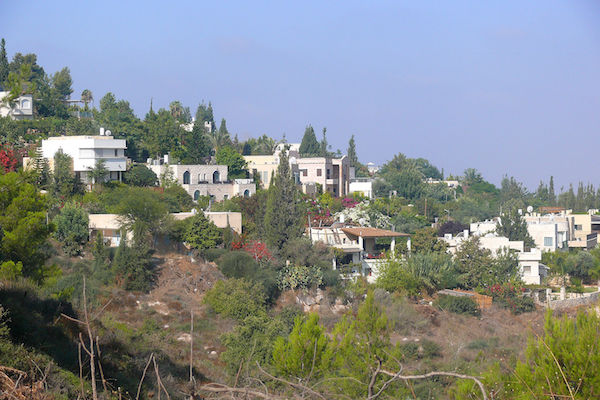A mixed Jewish-Arab couple is discouraged from applying to live in what many look to as a model for coexistence in Israel-Palestine.
By Orna Akad (translated by Ofer Neiman)

No, this is not a new book which I have just published, nor is it a new play. This is my life with Fouad, which has given me a few minutes of fame.
The furor last summer over the marriage of Mahmoud and Morel led me to my virtual photo album, in order to publish a family photo. I wanted to show that it’s both possible and desirable to live differently.
Alongside numerous insults, there were congratulations by Arabs and Jews. My mailbox was showered with moving personal stories and the understanding that this is the way to live together.
And here I am in front of the computer, recalling a bitter disappointment, not caused by the activists of [the anti-miscegenation group] Lehava, but by enlightened, tolerance-preaching people.
Twenty-three years ago, while my spouse Fouad and I were planning our life together, we were invited to give a workshop for Jews and Arabs in the Neve Shalom/Wahat al-Salam community.
On one side, the pastoral landscape, a view of the Monastery of Silence (Latrun) and the hummus field, and on the other side the bilingual school, instilled in us the feeling that this was the place where we wished to build our life together.
One of the participants in the workshop was also a member of the community’s admission committee.
She herself is married to a non-Jewish European guy.
We came up to her, full of hope, and said proudly that we are a couple, a Jewish woman and an Arab man, and that we would like to register and appear before the community’s admission committee.
The woman’s face turned serious all of a sudden and changed color. She looked at us sternly and said:
“You may apply for membership, but personally, I must tell you that I am opposed to admitting a couple like you into our community.”
We raised an eyebrow.
“Look, we are a community which encourages life together in coexistence, Jews alongside Arabs, but we are opposed to mixed marriage.”
“But your husband is also not Jewish,” I said.
“It’s not the same thing,” she responded adamantly, and then said, “you need to understand where we live. What will happen with the kids, and when they reach the age of military service, what will they do? And to what religion will they belong? And we are not naive, in the background there’s the Jewish Arab conflict.”
My spouse turned back immediately and I just said, “but we are looking for a way to live together in spite of the conflict. And besides, religion is a personal matter and … so is the decision on military service.”
By the time we left the illusion of coexistence there had evaporated right in front of us.
The scene was no longer pastoral, and the shaded view of the monastery in the sunset light even seemed scary.
The years went by. We were married a civil ceremony in Cyprus, we made our home in central Israel, and the Neve Shalom episode was forgotten.
Until quite some time later, when we arrived at the [Neve Shalom] guesthouse with friends, “people of peace,” on the left side of the political map.
Our friends looked at us with question marks on their faces: Why don’t you live in a place like this? This is an ideal place for you.”
We already had two children. My son was still a baby and my daughter was in elementary school.
I said to them with a smile, “but the neighbors…”
(As in Leah Goldberg’s [Israeli] children’s book A Flat for Rent, in which a visitor is asked: “Do the rooms please you? Does the kitchen please you?” To which she responds: “They do,”and then when the tenants invite her, saying, “so come and dwell with us,” the visitor responds by saying: “No, I will not. The neighbors do not please me.”)
I added: “Neve Shalom is coexistence in an illusion. Mixed couples are not admitted here”
One of our friends refused to believe, went over to the woman from the guesthouse, introduced us, and then asked why such a couple (a Jewish woman and an Arab man) cannot be admitted into a community like Neve Shalom.
The woman responded, shamelessly, that “Neve Shalom cannot serve as a haven for mixed couples.” But she would be very glad if mixed couples established their own community, and she would walk hand in hand with us to establish one.
Our friend didn’t skip a beat before responding, “Look at them, do you think they need a haven? I suggest that tomorrow, all those who own poodles establish a community. What do you think? Shall we support them? What was your wording? We’ll ‘Walk with them hand in hand’.”
Orna Akad is an author, playwright and theater director. She has been nominated for the Sapir literature award for her novel, “Wadi Mileh,” and is the winner of the AKUM Prize (Society of authors, composers and music publishers in Israel). Orna divides her personal and professional life between the two societies, Arab and Israeli.
Editor’s note:
There is no official prohibition on the admission of mixed Jewish-Arab families in Neve Shalom, but this is not the only case of mixed couples being discouraged from applying to live there.

